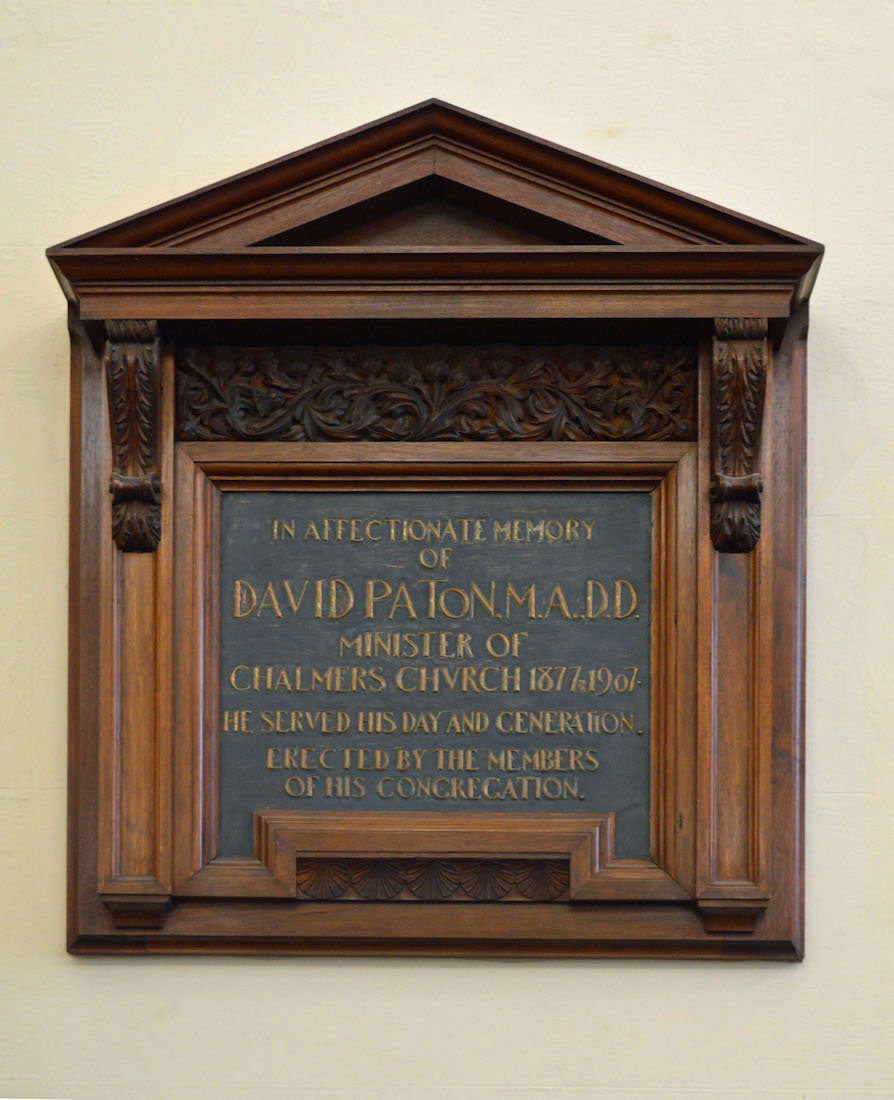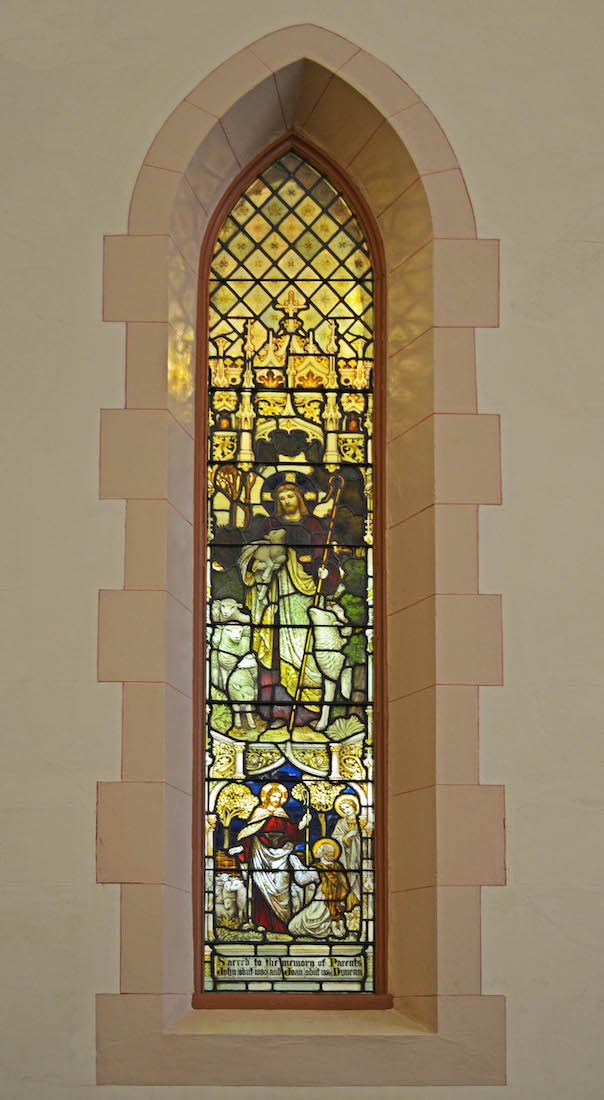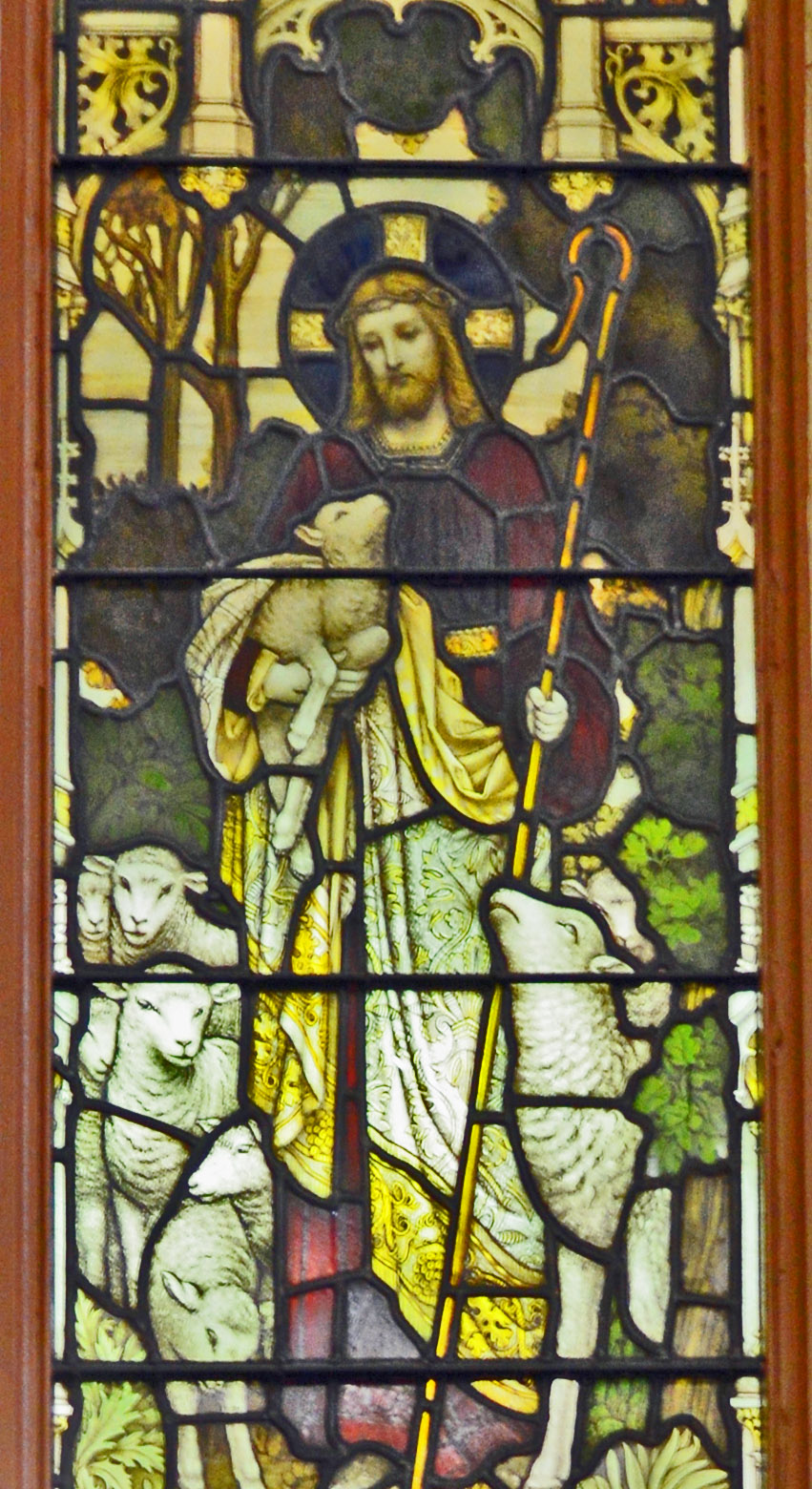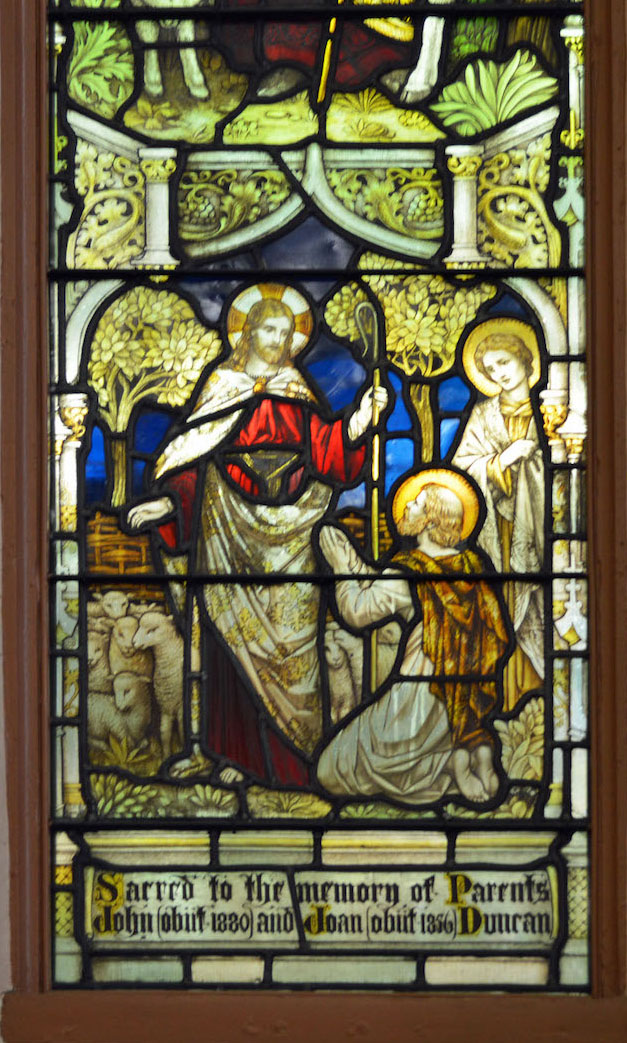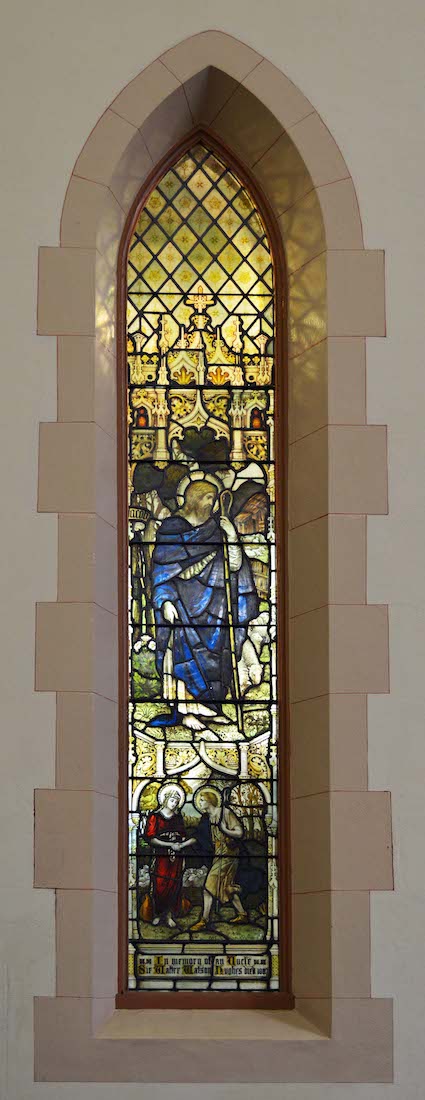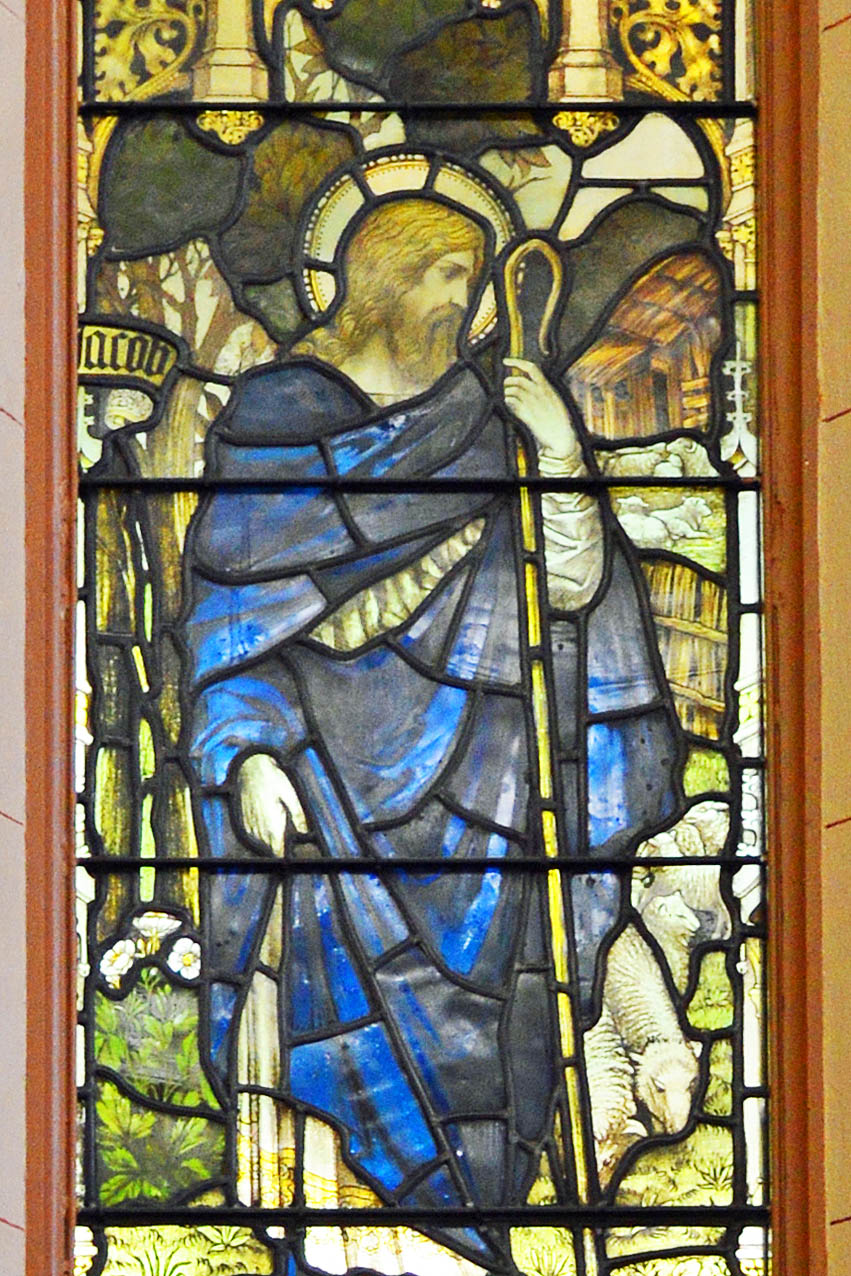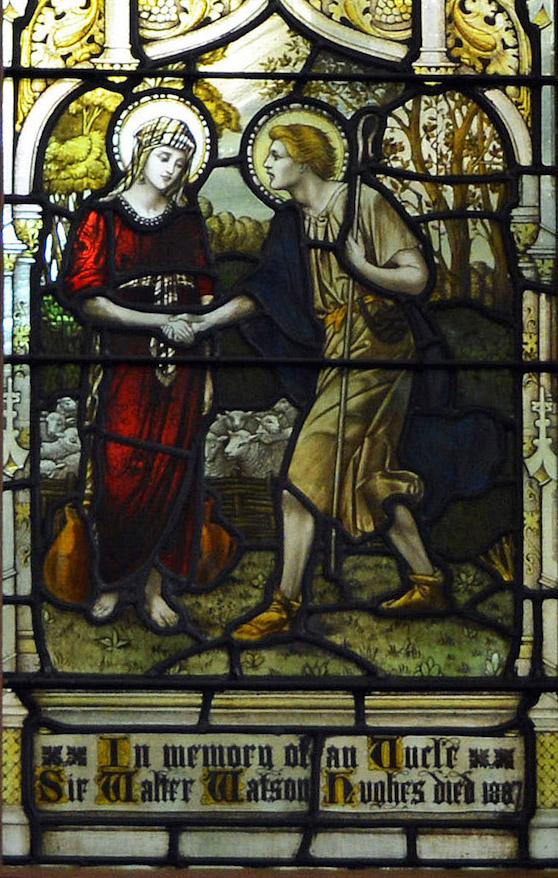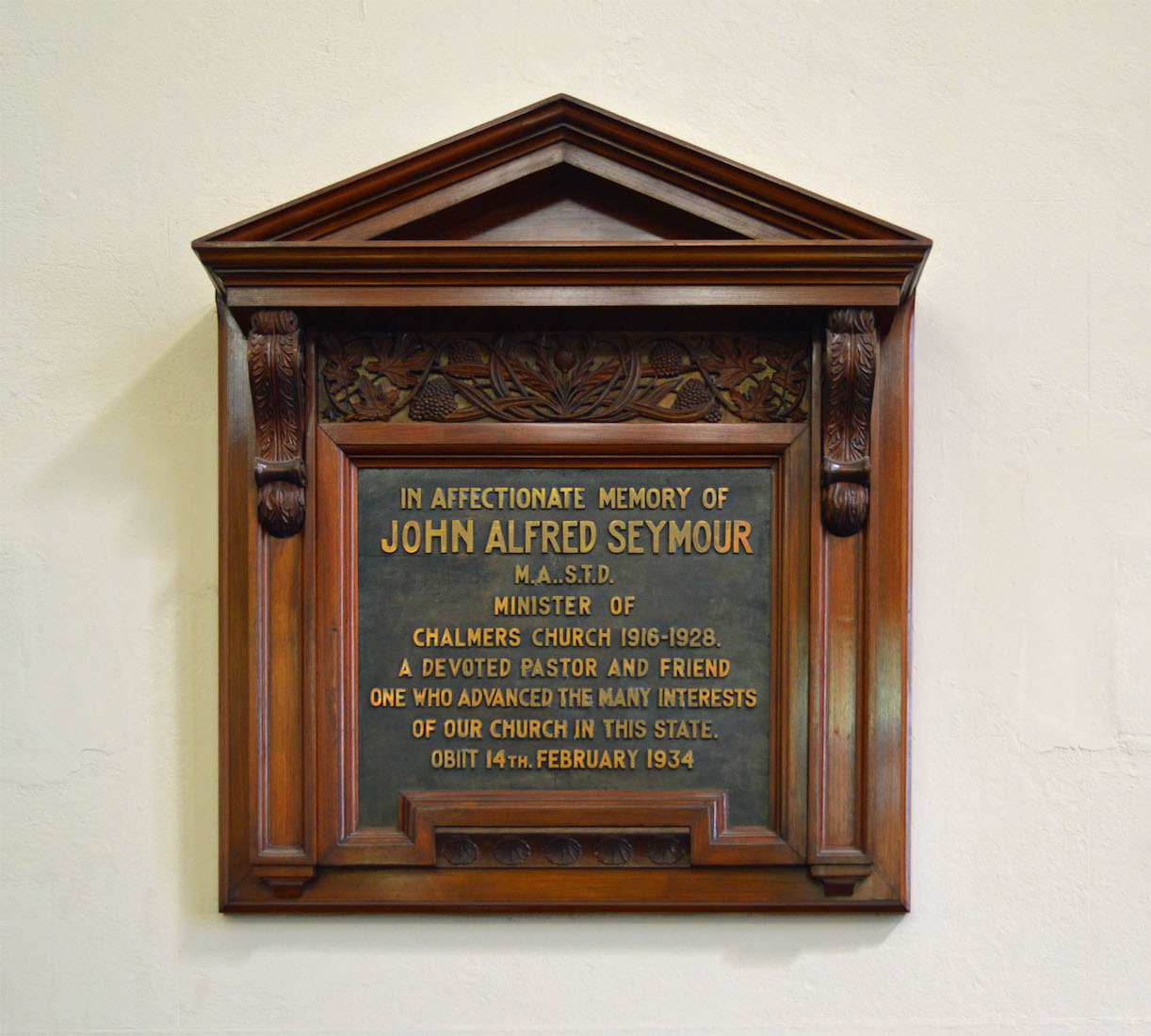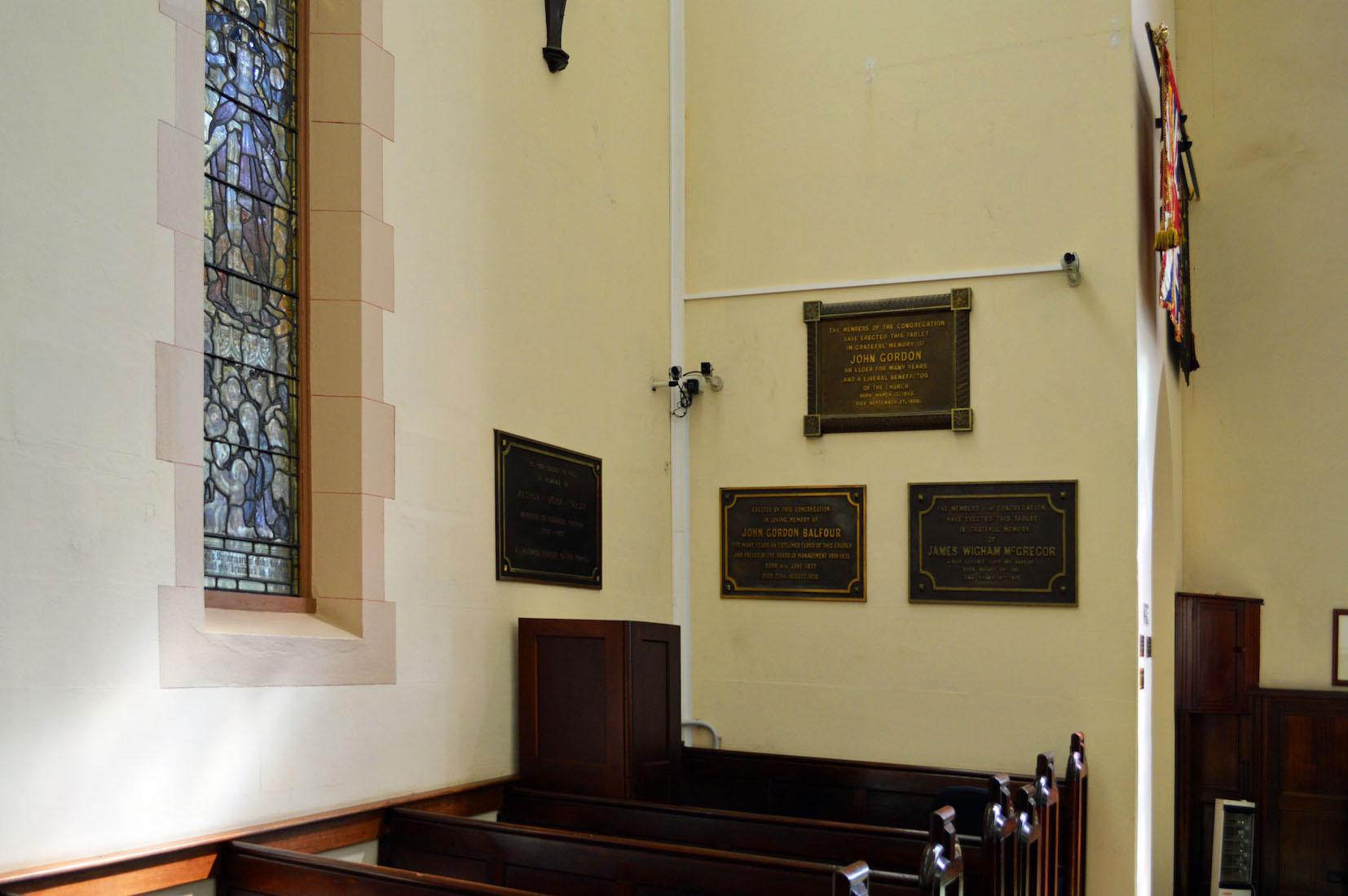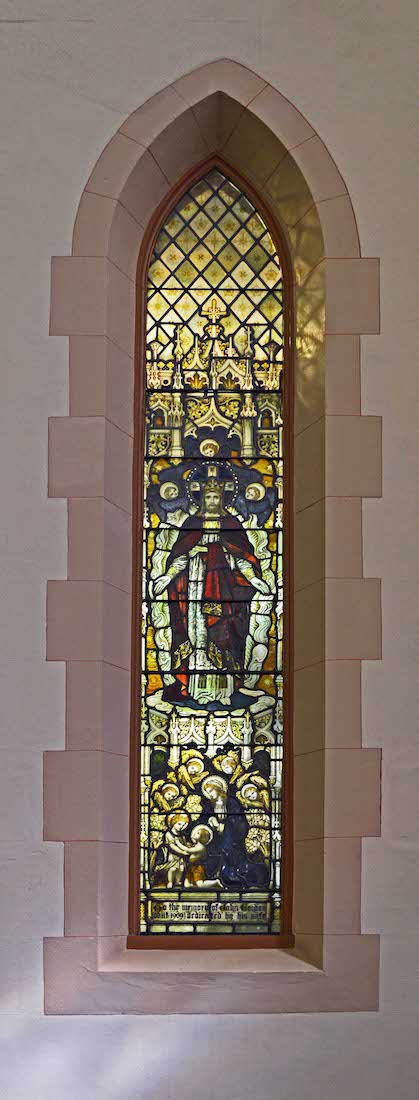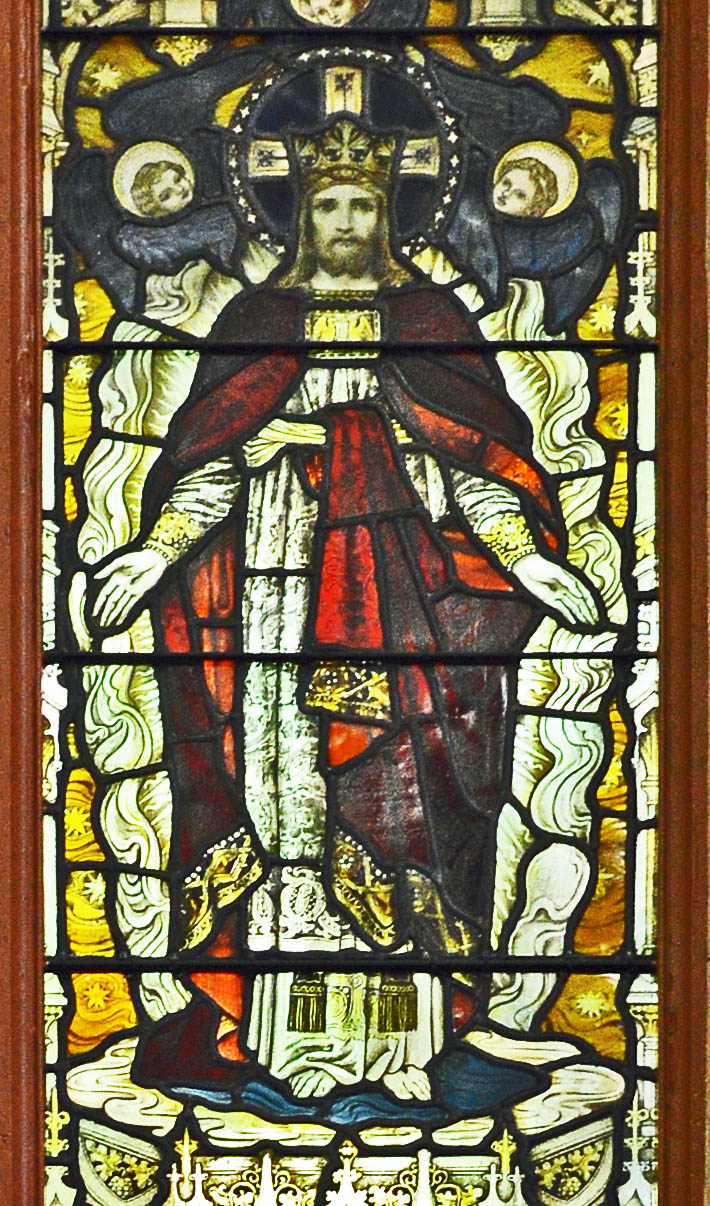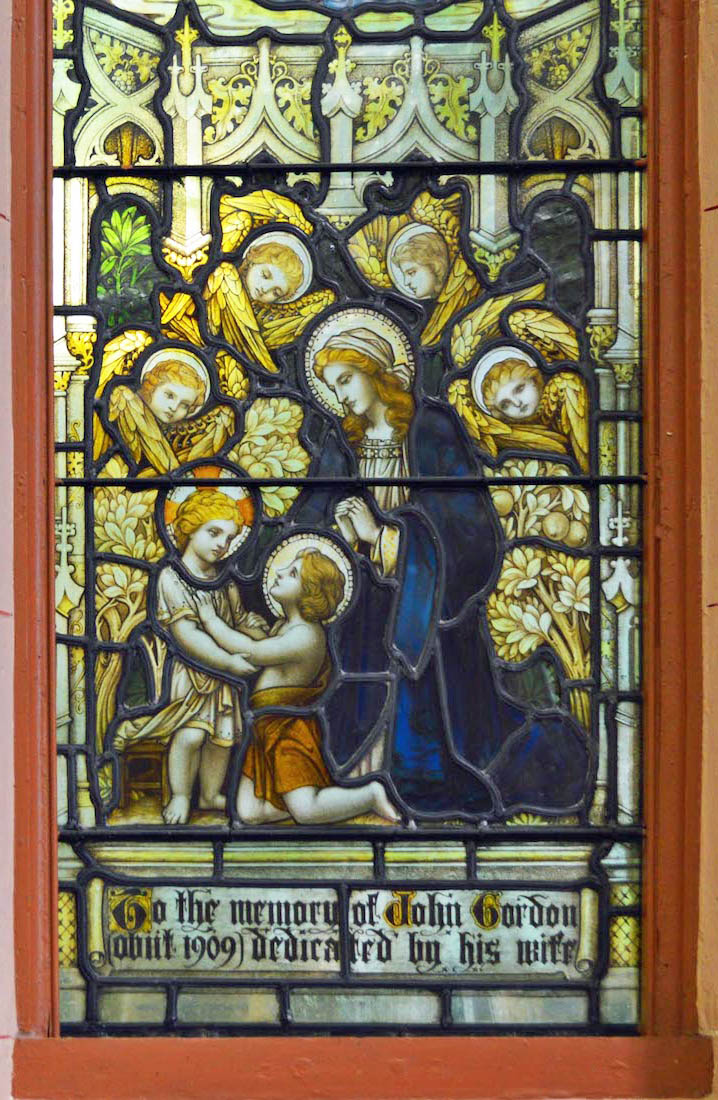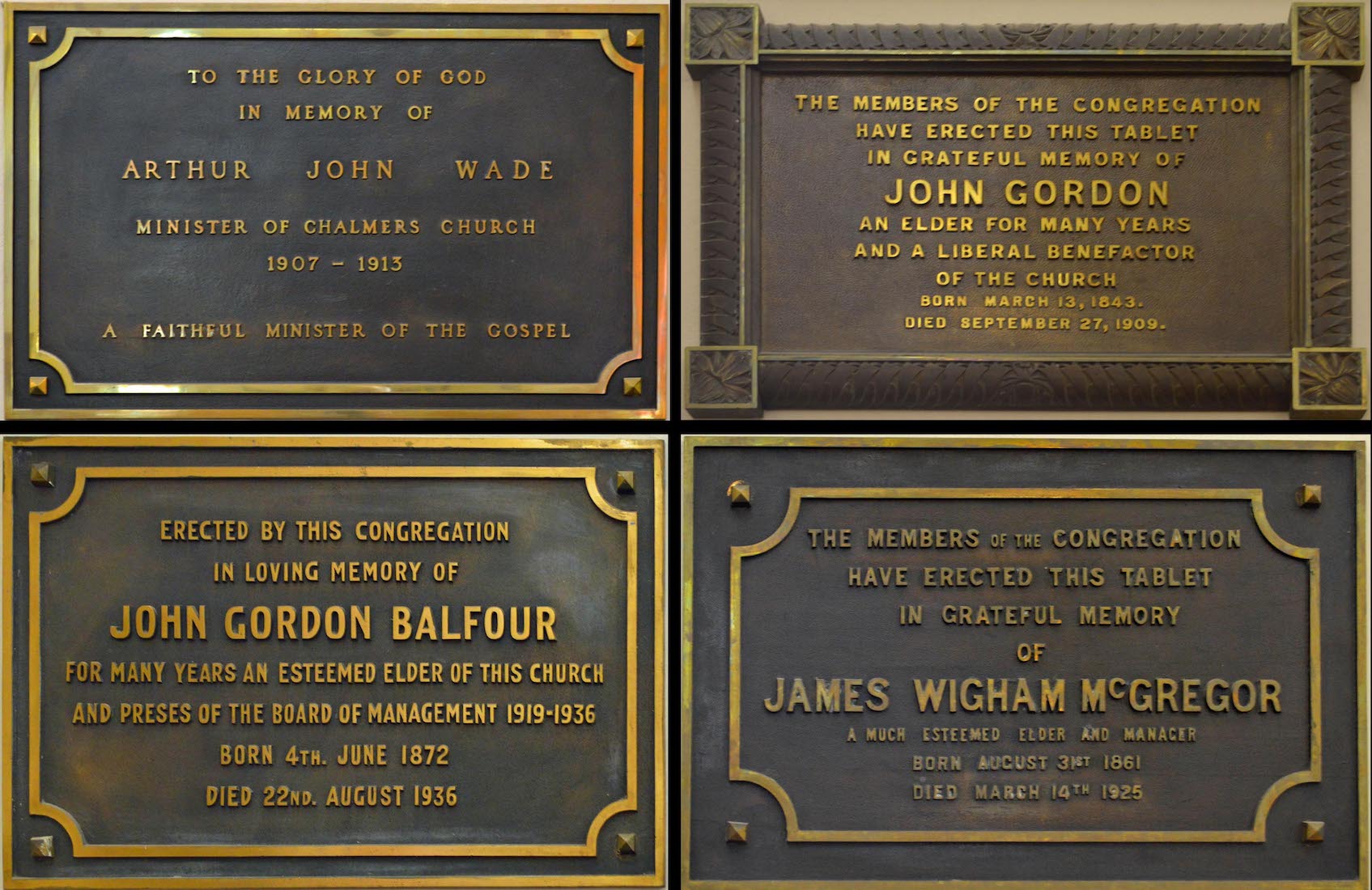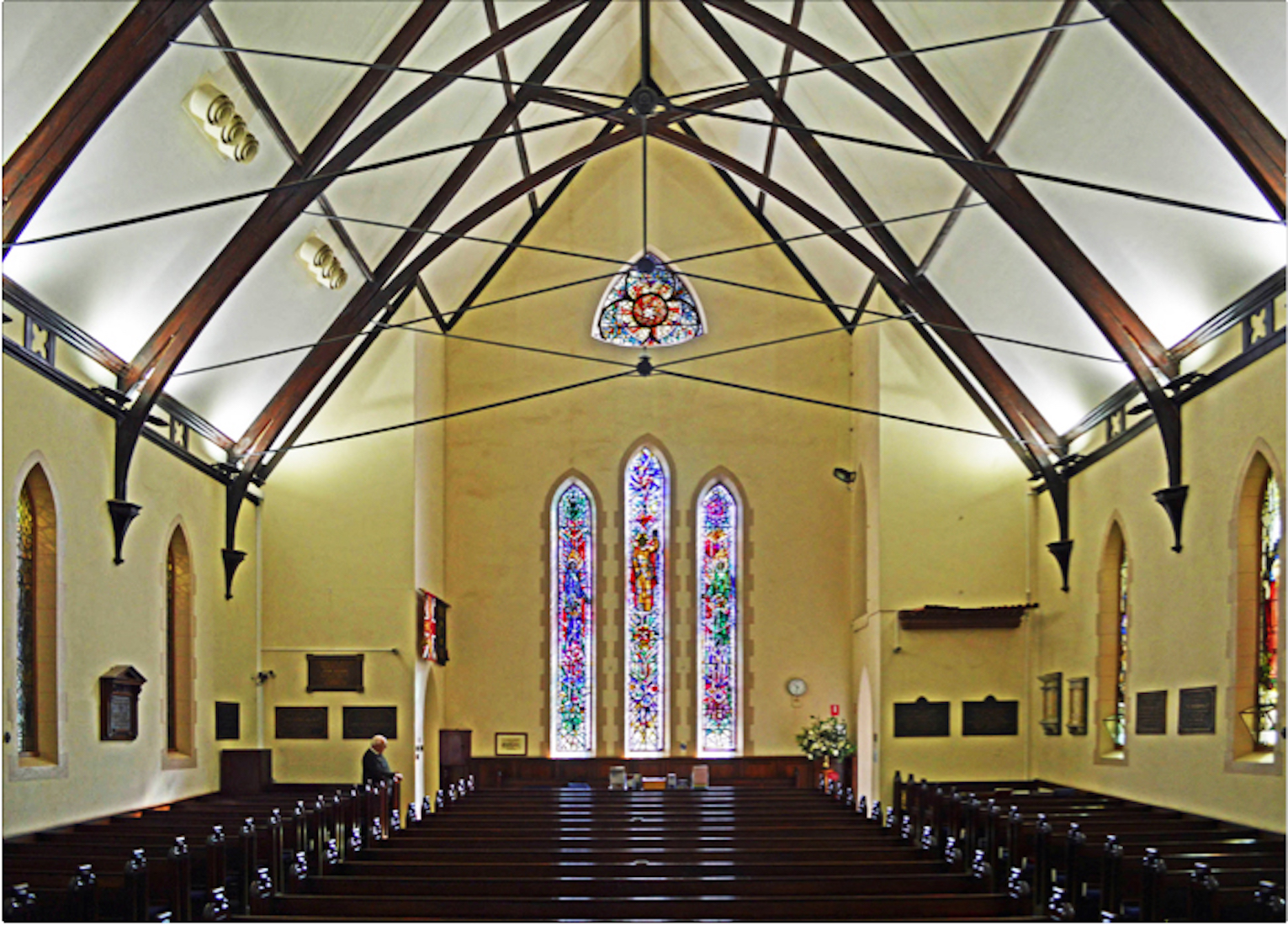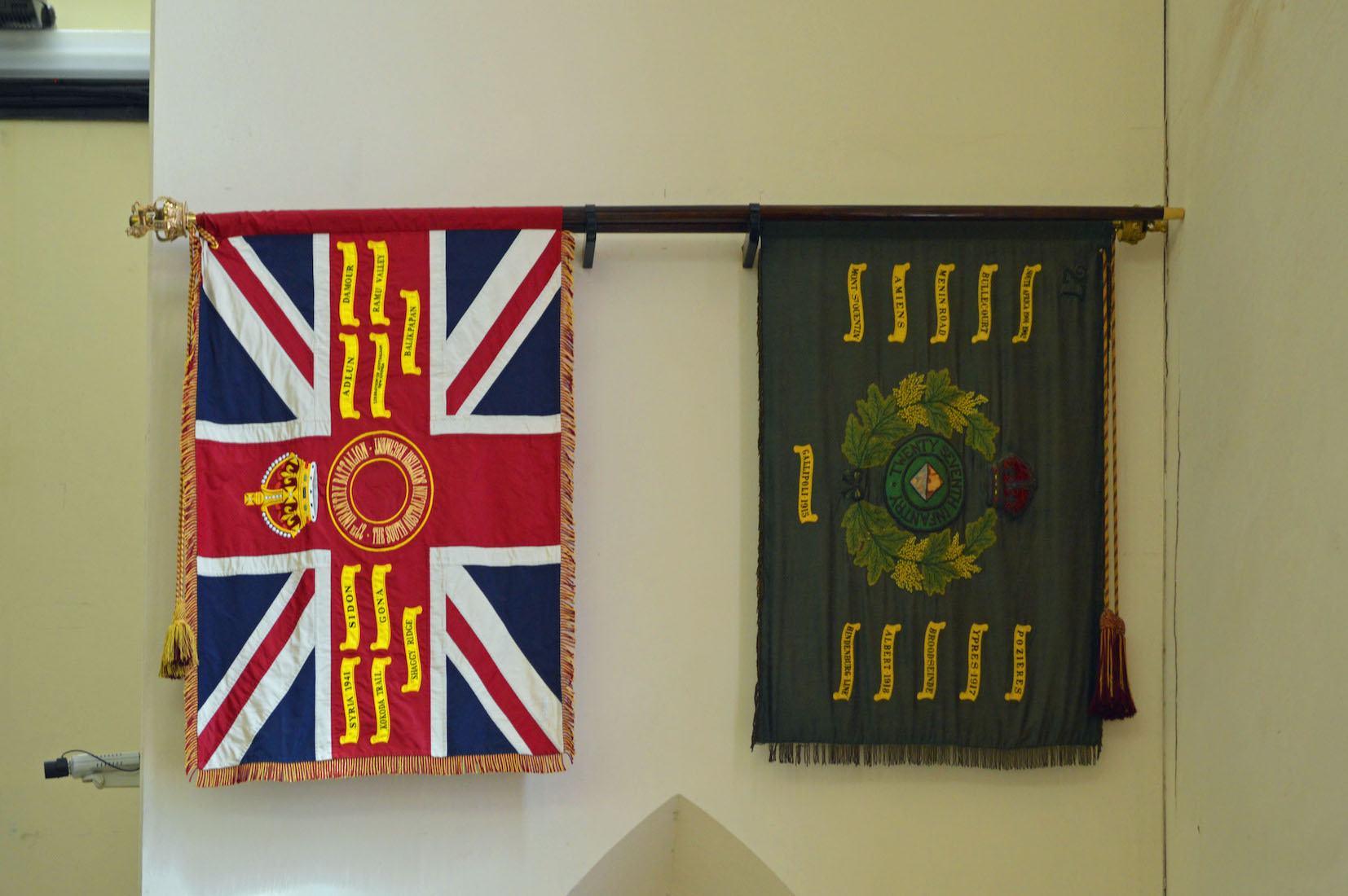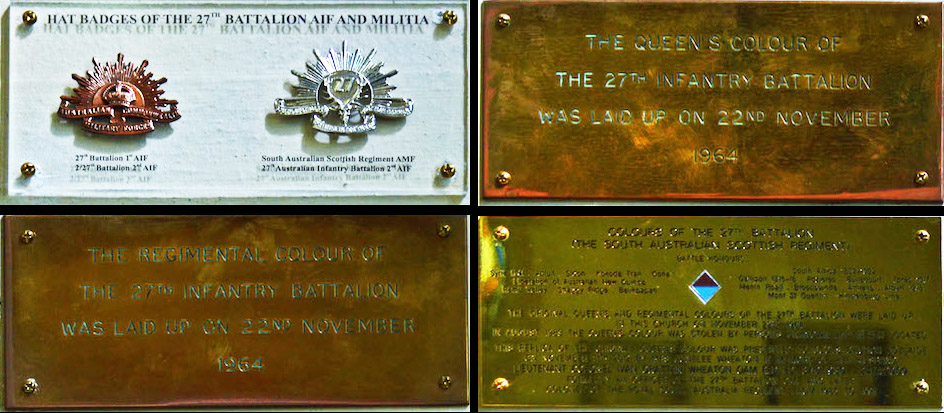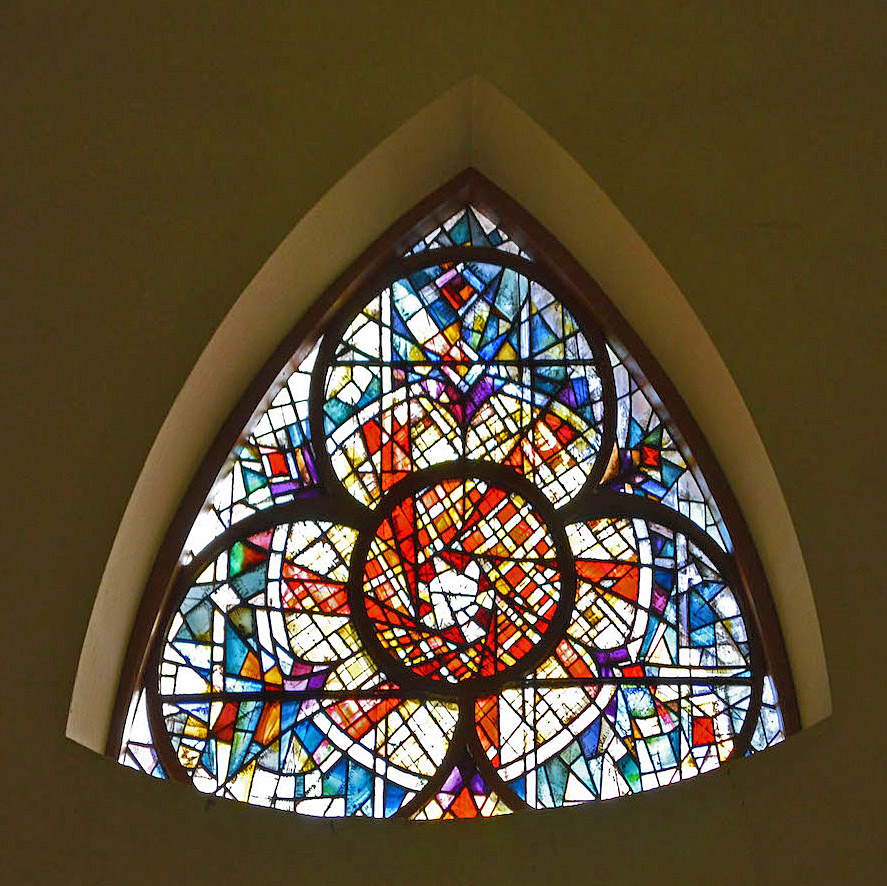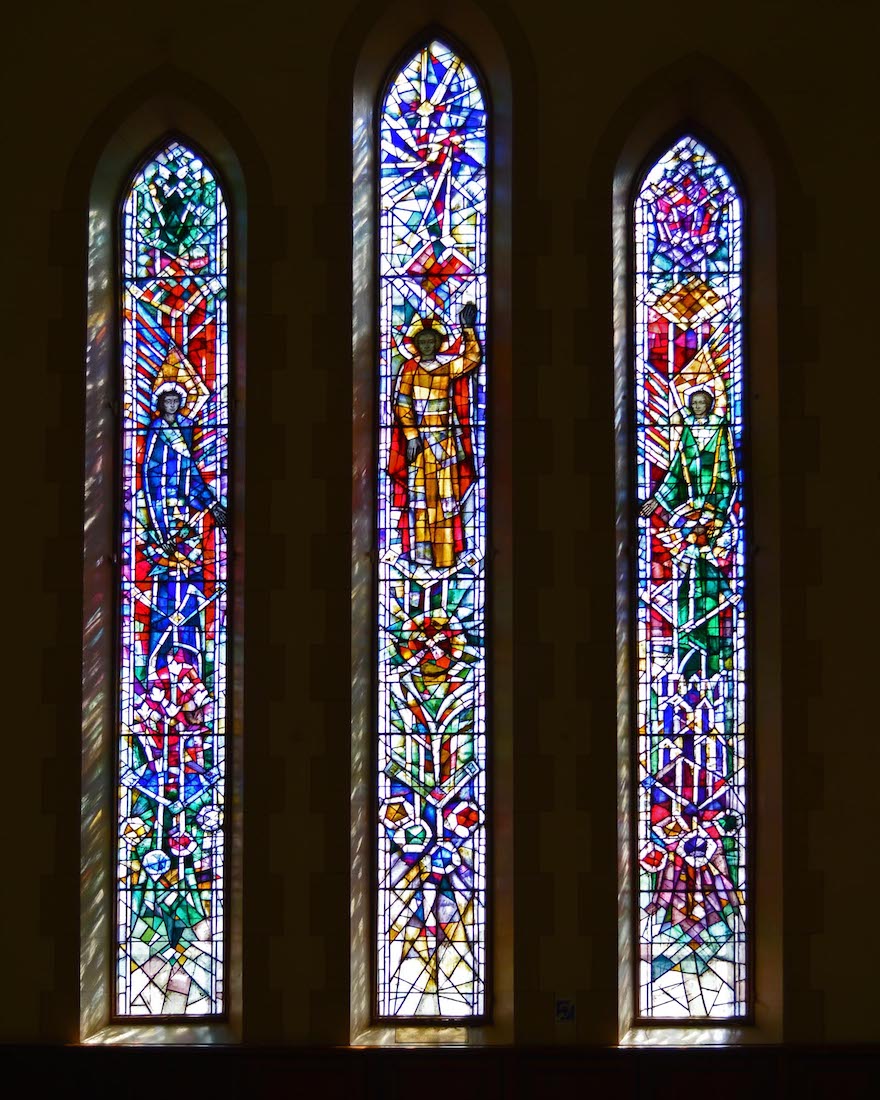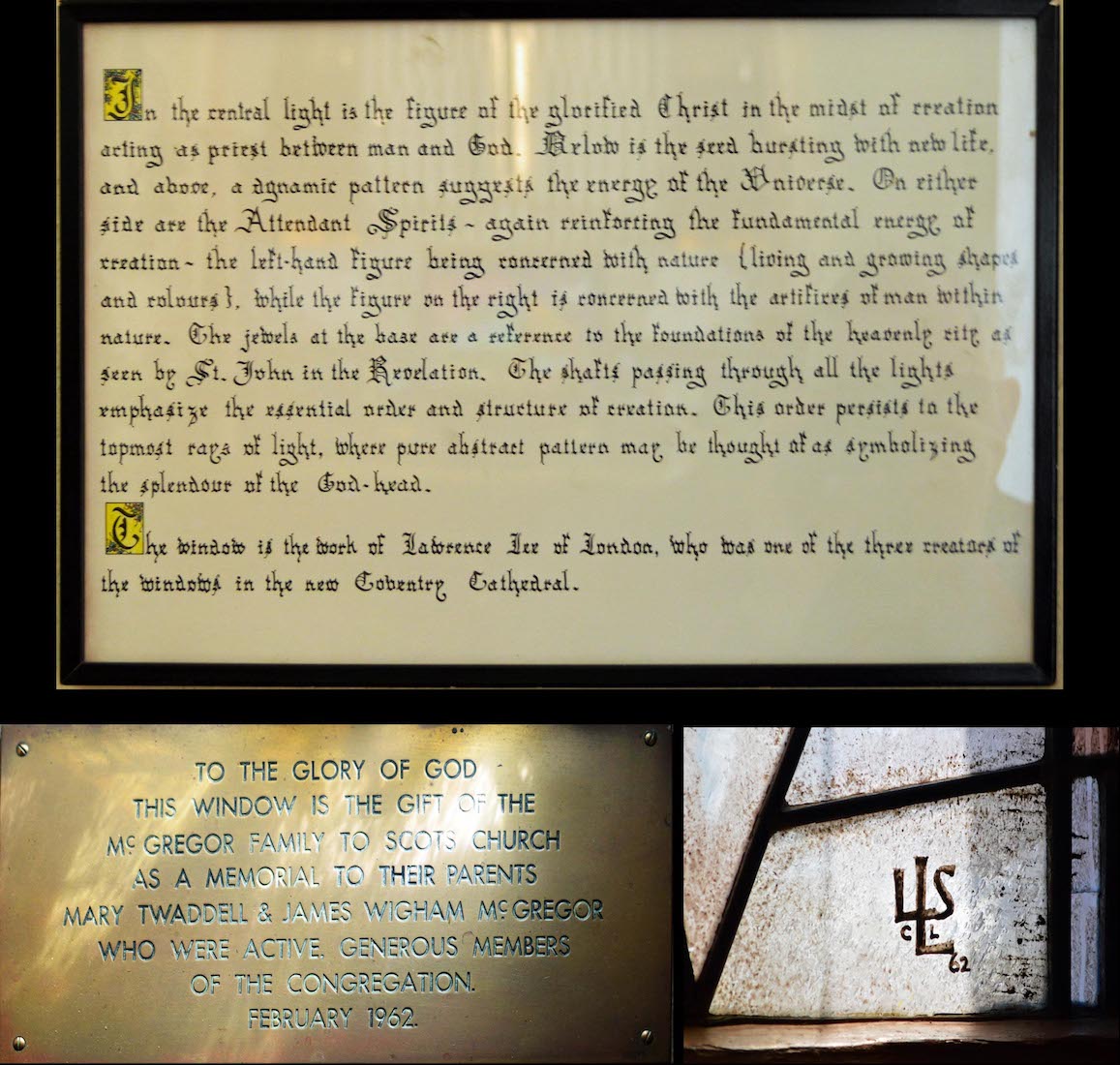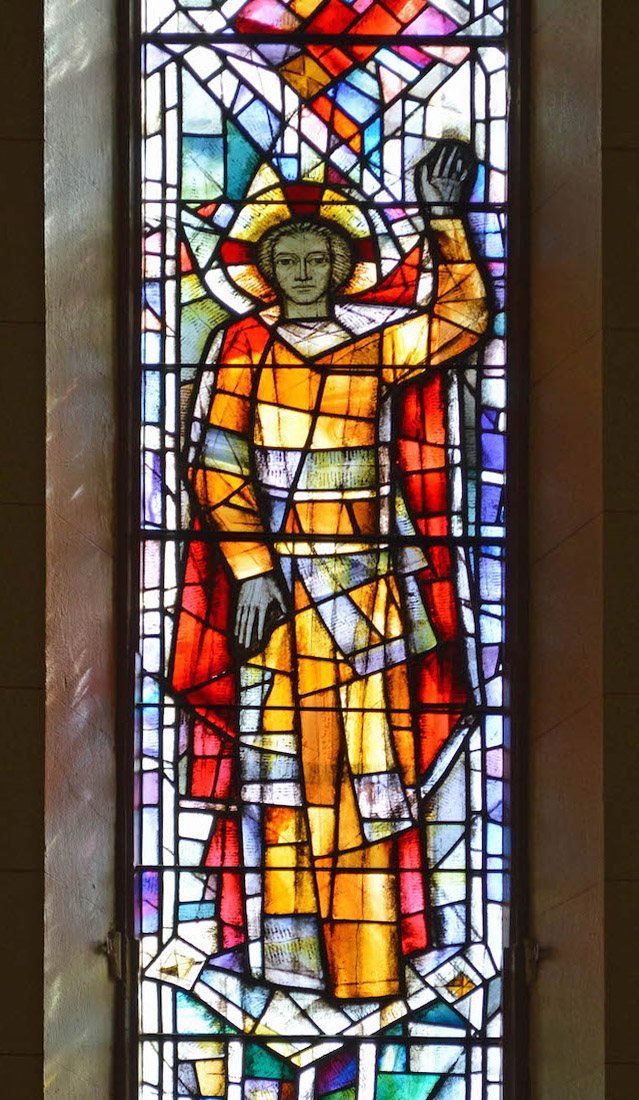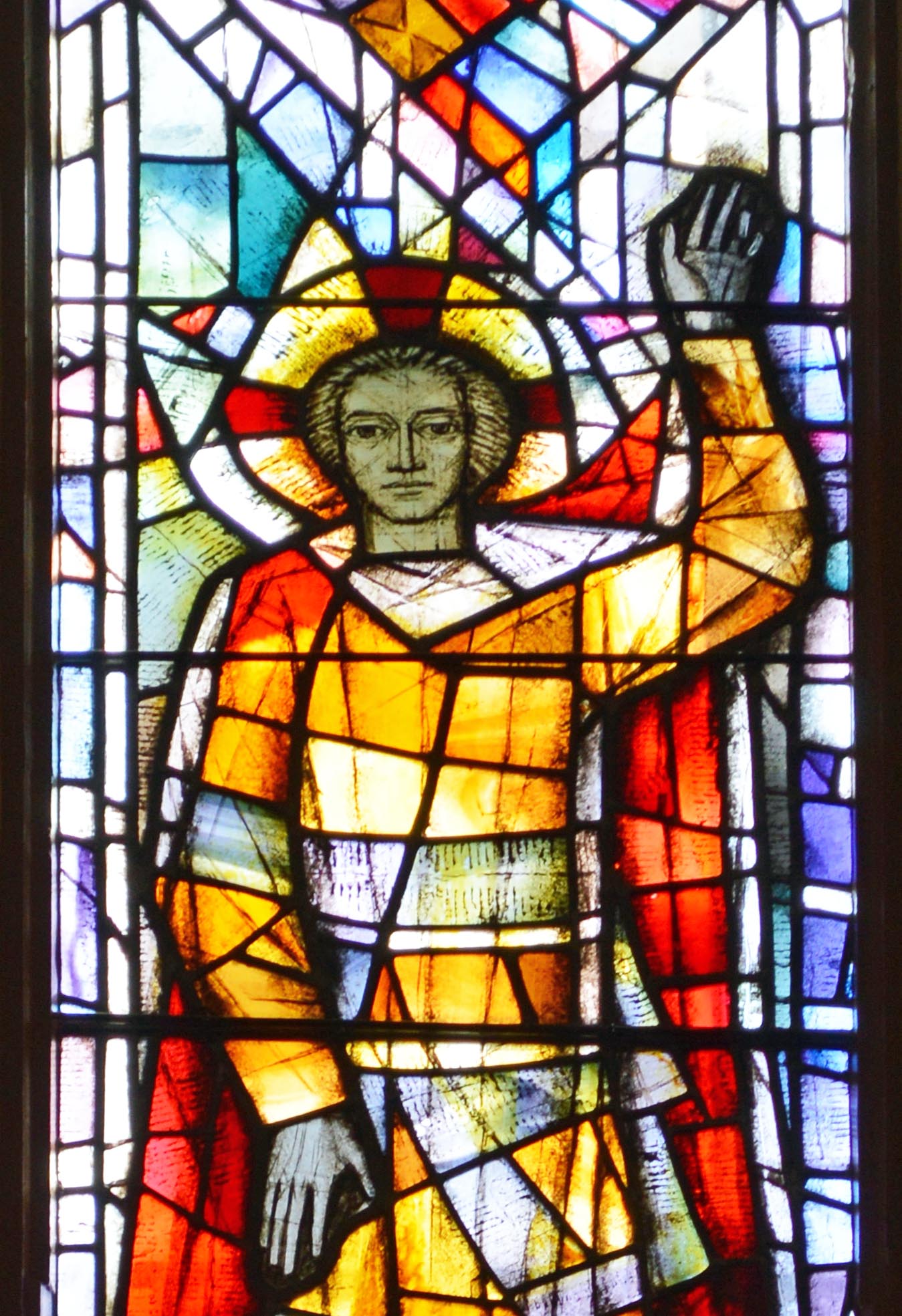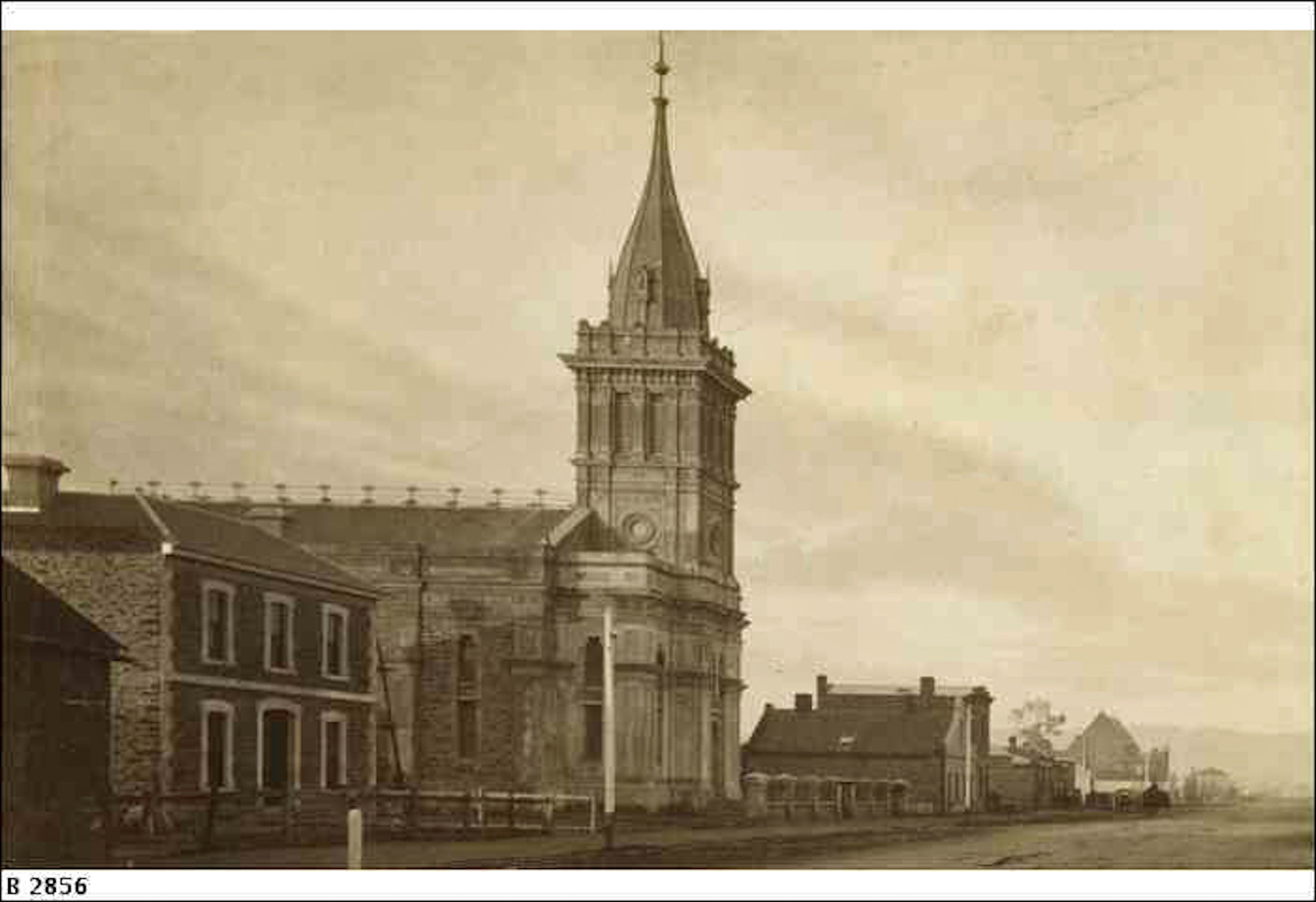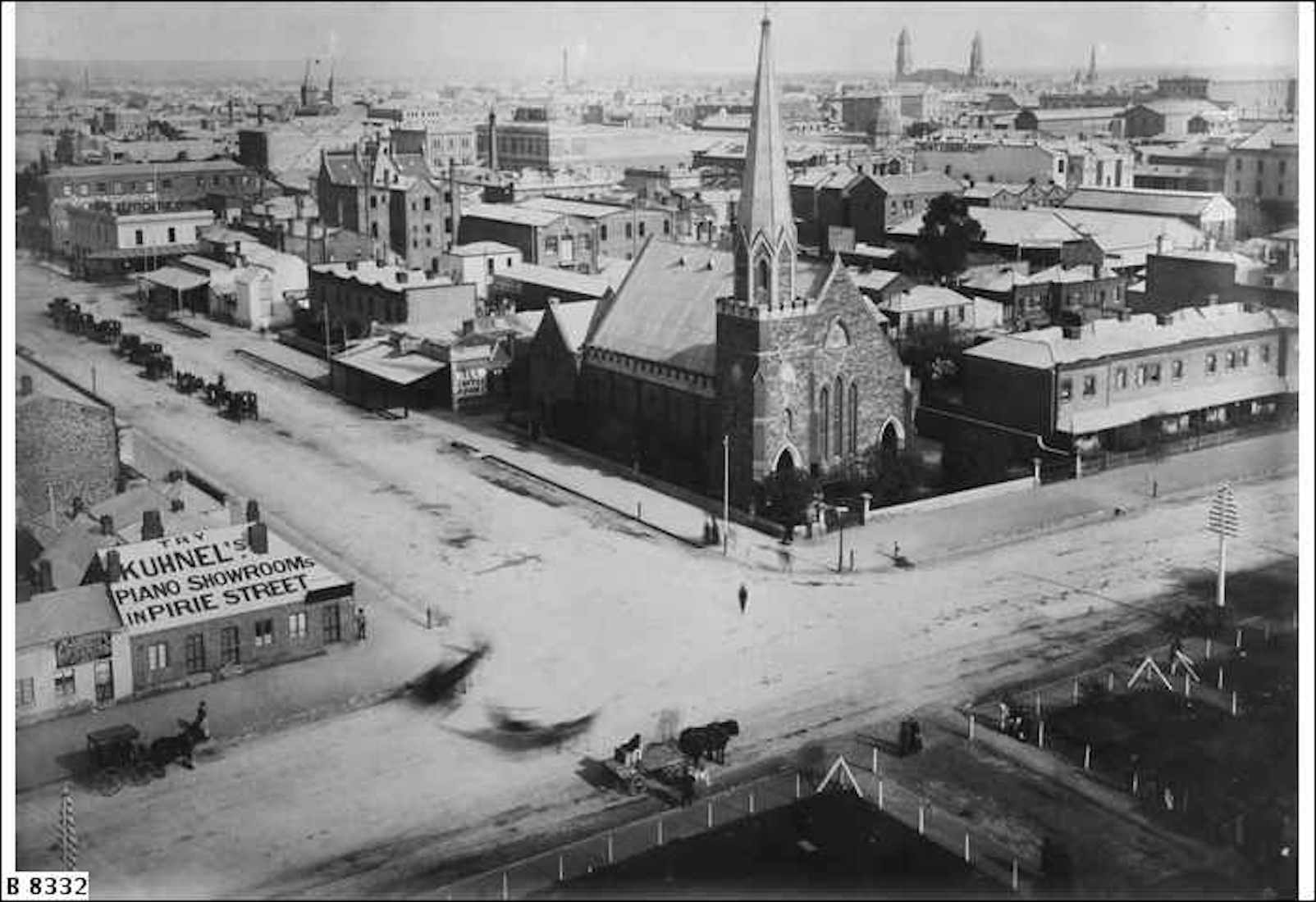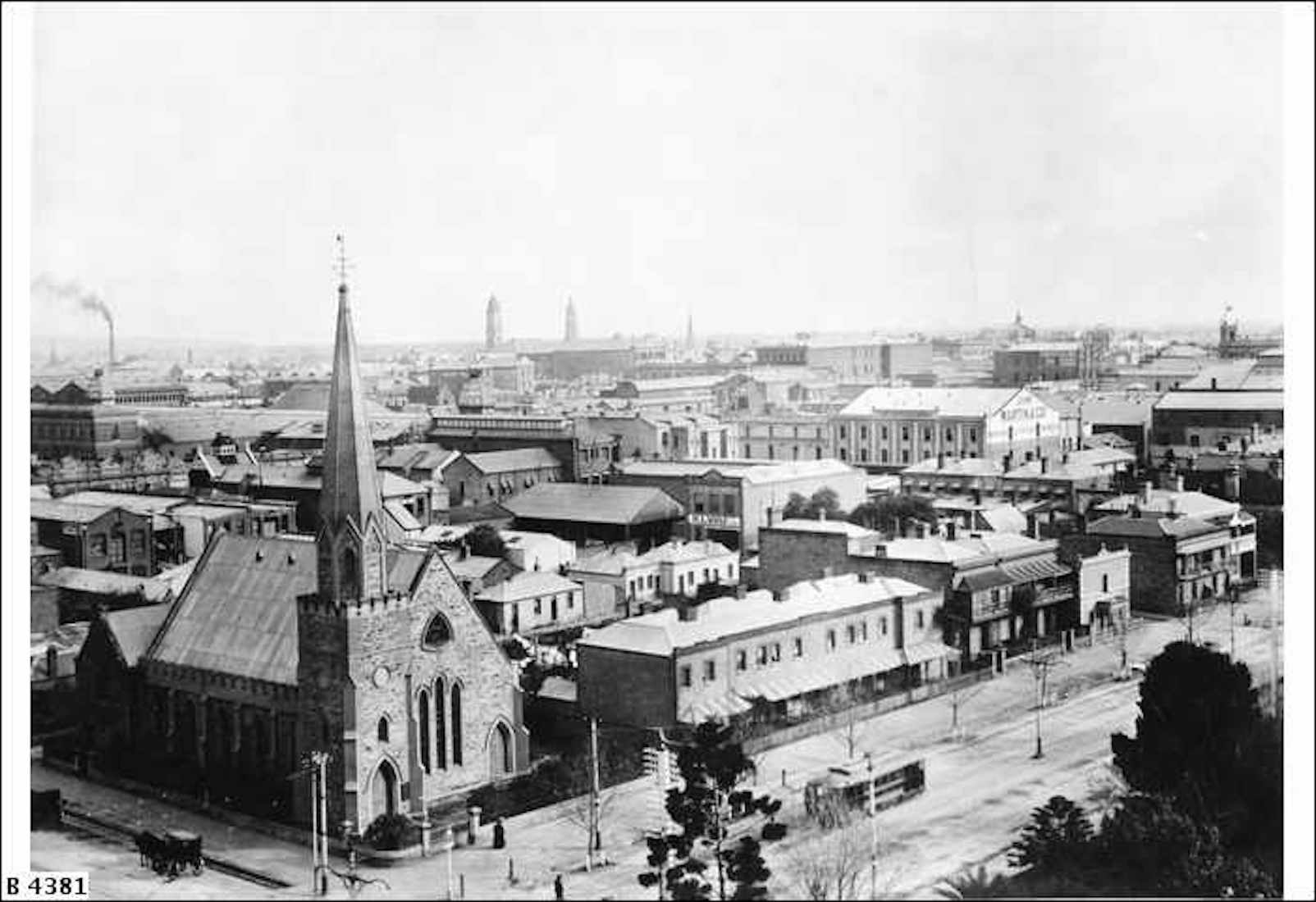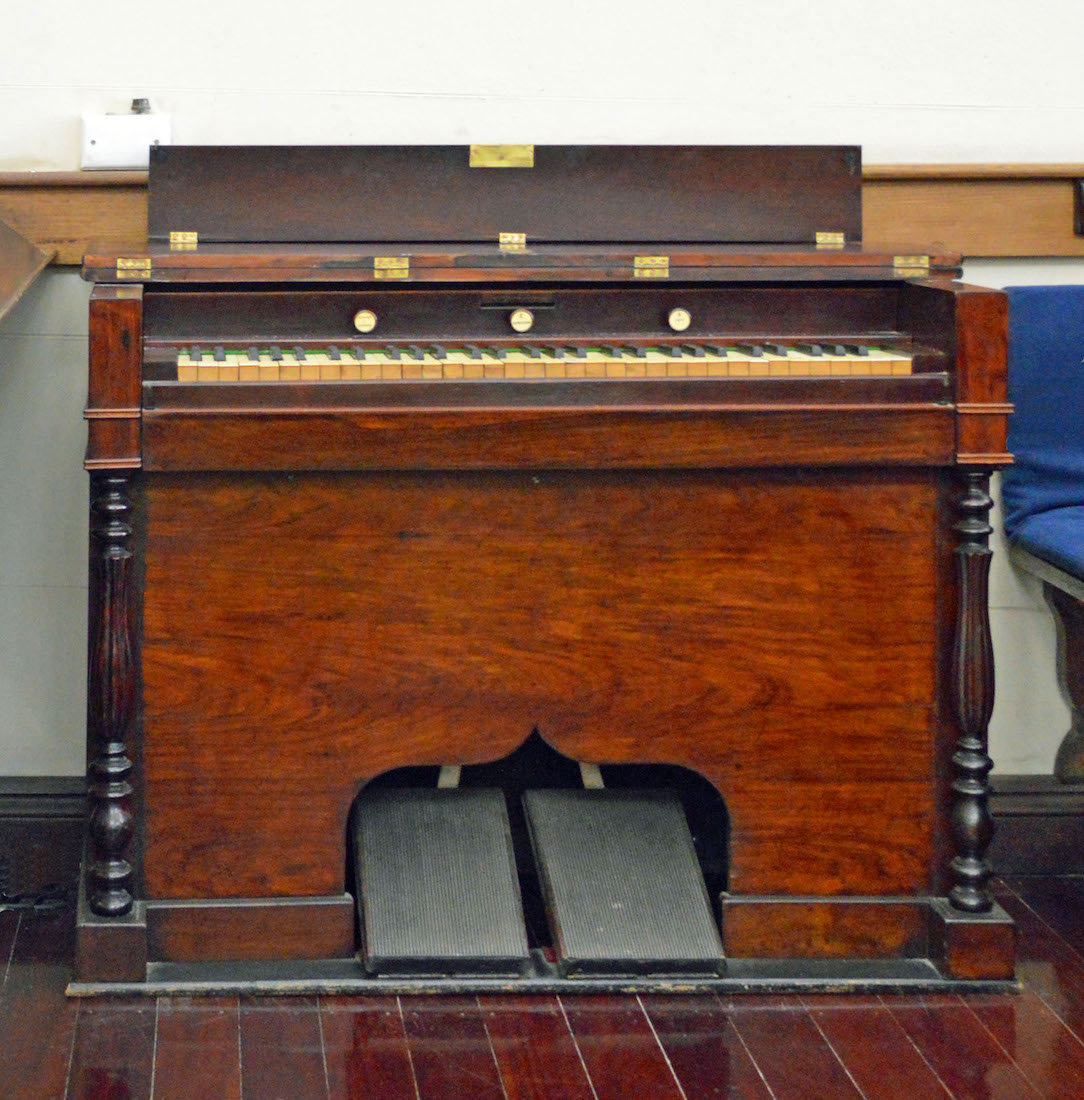

For the first 5 years, singing in Chalmers Church was led by a precentor with a tuning fork. Only metrical psalms and paraphrased scripture passages were sung. The congregation sat for singing and stood for prayers. In 1868, an harmonium was introduced into Chalmers. It cost £80. The harmonium bears a Medal of Honour from the Paris Exhibition of 1865. In 1900, a pipe organ (‘a kist of whistles’) built by Josiah E Dodd was installed to replace the harmonium. The organ cost £632 which was raised by subscription. The harmonium was sold for £20, but has since been reacquired, and is displayed near the current organ console. INDEX
42. SOUTH WALL
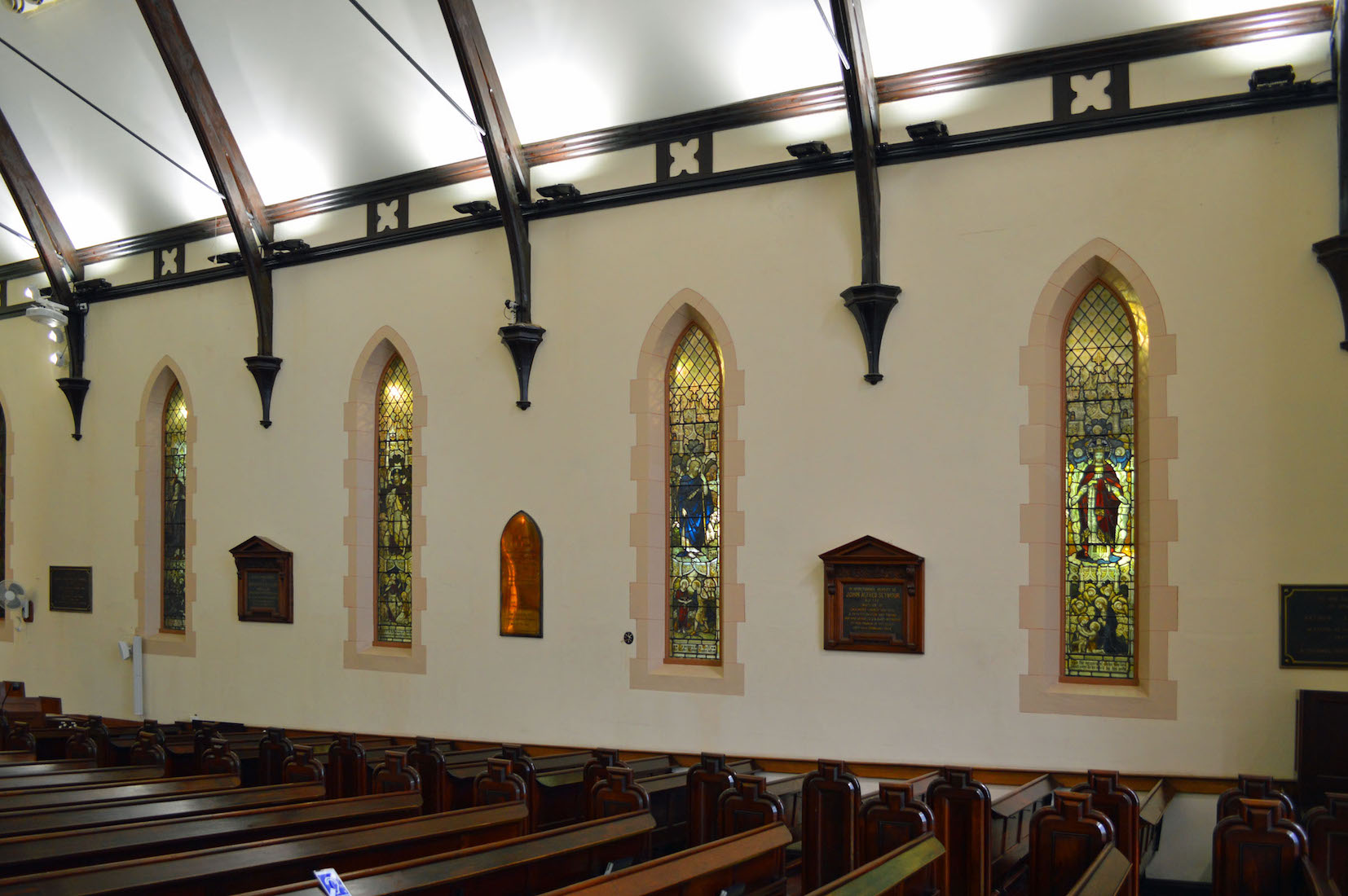
42. We are now going to investigate the remaining windows and memorials of the South wall. In this view, we can see the organ and harmonium at extreme left.
43. MEMORIALS
Two more memorials ... . The text at left reads: ‘In affectionate memory of David Paton MA DD Minister of Chalmers Church 1877 – 1907. He served his day and generation. Erected by the members of his congregation. The text on the brass plate reads: ‘To the memory of the Revd John Davidson MA Minister of Chalmers Church 1870 – 77 Born at Kinghorn Fifeshire 1st July 1834. Ordained by the Presbytery of Dumfries 17th March 1864. First Hughes Professor of Language & Literature & Mental & Moral Philosophy in the University of Adelaide. Died 22nd July 1881. ... Also Harriet his wife, daughter of Hugh Miller of Cromarty Died 21st Dec 1883.’
44. GOOD SHEPHERD WINDOW
This window depicts two scenes. The upper one shows Jesus as a shepherd, carrying a lamb under one arm, and holding a shepherd’s crook. The lower scene retains the shepherd theme, but shows Jesus as a pastor to people. The script at the bottom reads: ‘Sacred to the Memory of Parents John (obit 1880) and Joan (obit 1856) Duncan’.
45. JACOB WINDOW
The next window on the South wall shows two scenes from the life of Jacob. The main picture is of an older Jacob tending his (or Laban’s) flocks. The lower panel depicts the young Jacob meeting Rachel at the well. The script at the bottom reads: ‘In memory of an Uncle, Sir Walter Watson Hughes died 1887’.
46. SEYMOUR MEMORIAL
The next memorial we come to reads: ‘In affectionate memory of John Alfred Seymour MA STD Minister of Chalmers Church 1916 –1928. A devoted pastor and friend. One who advanced the many interests of our church in the State. Obit 14th February 1934. The complete history of this church is recorded in its wall plaques!
47. SOUTHWEST CORNER
We now have one more stained glass window on the South wall. There are four tablets in this corner, and then to the right we catch a glimpse of a war memorial feature: two flags with four small items on the wall below.
48. RISEN LORD WINDOW
This last window depicts Christ as the Risen Lord crowned King. The scene in the lower panel perhaps depicts the child Jesus being embraced by a young John the Baptist while Mary looks on. The text at the bottom reads: ‘To the memory of John Gordon (obit 1909) dedicated by his wife.
49. FOUR CORNER PLAQUES
These tablets are easy to read. • ... In memory of Arthur John Wade Minister of Chalmers Church 1907–1913 ... • The members ... have erected this table in grateful memory of John Gordon, an Elder for many years and a liberal benefactor of the church Born March 13, 1843 Died September 27, 1909. • Erected ... in loving memory of John Gordon Balfour For many years an esteemed Elder of this church and Preses of the Board of Management 1919–1936 Born 4th June 1872 Died 22nd August 1936. • ... In memory of James Wigham McGregor, a much esteemed Elder and Manager Born August 3rd 1861 Died March 4th 1925.
50. WEST WALL
50. We complete our tour of Scots Church by investigating more closely the recessed west wall where we entered. The flags and war memorabilia at left are more clearly seen here. At centre we have the triple lancet windows, and the rounded triangular window above. To the left of the lower windows is a general framed certificate recognizing the historical nature of the church. A detailed explanation of the windows is in fact hiding behind the flower arrangement at right!
51. COLOURS
The two Regimental Colours are of the 27th Infantry Battalion : The South Australian Scottish Regiment. Fields of action are listed on the flags. These are: Syria 1941, Sidon, Kokoda Trail, Gona, Shaggy Ridge, Adlun, Damoor, Liberation of Australian New Guinea, Ramu Valley, Balikpapan; South Africa 1901 – 1902, Bullecourt, Menin Road, Amiens, Mont St Quentin, Pozieres, Ypres 1917, Broadseinde, Albert 1918, Bindenburg Line, Gallipoli 1915.
52. BADGES AND PLAQUES
52. Top left are two mounted hat badges of the 27th Battalion AIF and Militia. The adjacent plaques read: ‘The Queen’s / Regimental Colour of the 27th Infantry Battalion was laid up on 22nd November 1964’. Bottom plaque, main text: The original Queen’s Regimental Colours of the 27th Battalion were laid up in this Church on November 22nd 1964. In August 1983 the Queen’s Colour was stolen by persons unknown and never located. This replica of the original QC was presented to Scots Church on November 11th 2012 by Mrs Junelee Wheaton in memory of her husband Lieutenant Colonel Ivan Gratton Wheaton OAM RFD ED 3/10/1930 – 24/4/2009, formerly an Officer of the 27th Battalion and later Colonel of the SA Regiment from 1985 to 1991.’
53. HIGH WEST WINDOW
This high triangular window has an abstract pattern. All the windows on this wall were created in 1962 by Laurence Lee of London, one of the three creators of the windows in the new Coventry Cathedral.
54. MAIN WEST WINDOW
The main West window floods the church with its spectrum of bright colours. The figure in the central light is the glorified Christ. The side panels depict the Attendant Spirits. The set of three panels are named ‘The Celebration of Creation’. We read the artist’s description shortly.
55. WINDOW DESCRIPTION
‘‘In the central light is the figure of the glorified Christ in the midst of creation acting as priest between man and God.Below is the seed bursting with new life, and above, a dynamic pattern suggests the energy of the Universe. On either side are the Attendant Spirits – again reinforcing the fundamental energy of creation – the left hand figure being concerned with nature (living and growing shapes and colours), while the figure on the right is concerned with the artifices of man within nature. The jewels at the base are a reference to the foundations of the heavenly city as seen by St John in the Revelation. The shafts passing through all the lights emphasize the essential order and structure of creation. ... The artist’s initials are at bottom right of the window.
56. WINDOW DETAIL
The glorified Christ as depicted in the West window, seen close up ...This completes our tour of Scots Uniting Church.
57. FLINDERS STREET PRESBYTERIAN 1865
In 1929 the Flinders Street Presbyterian Church (FSPC) and Chalmers Church amalgamated under the new name of ‘Scots Church’. The two buildings were still used for worship, FSPC for morning worship and North Terrace in the evenings. The FSPC was sold in 1956 to the YMCA, and all activities were transferred to North Terrace. Additions to the North Terrace property were partially funded by the sale of FSPC. Bluestone saved from FSPC was used for the facings of the building. The current organ and South wall stained glass windows in Scots came from FSPC. [Photo Credit : FSPC ca 1865 : slsa : B2856]
58. CHALMERS FREE CHURCH 1887
Scots Church Adelaide was originally called ‘Chalmers Free Church’, named after the Rev Dr James Chalmers who established the Free Church of Scotland. It was built by a group of prominent Adelaide citizens, early immigrants to South Australia. Determined to establish a Free Church in Adelaide, this group called the Rev John Gardner from Scotland. He arrived in March 1850 and immediately he and the group set about purchasing the land on the corner of North Terrace and Pulteney Street, and building a church there. The foundation stone was laid on the 8th of September 1850, six months after Rev Gardner’s arrival. [Photo Credit : ca 1887 : slsa : B8332]
59. CHALMERS PRESBYTERIAN CHURCH 1911
The church building was officially opened for worship on July 6th 1851. The tower was added in 1858. In 1865 the three branches of Presbyterianism established in South Australia, the Free Church, the United Presbyterian Church, and the Church of Scotland, united to form one Presbyterian Church in South Australia. They became part of the Presbyterian Church of Australia at Federation in 1901. And so Chalmers Free Church became Chalmers Presbyterian Church. [Photo Credit : ca 1911 : slsa : B4381]
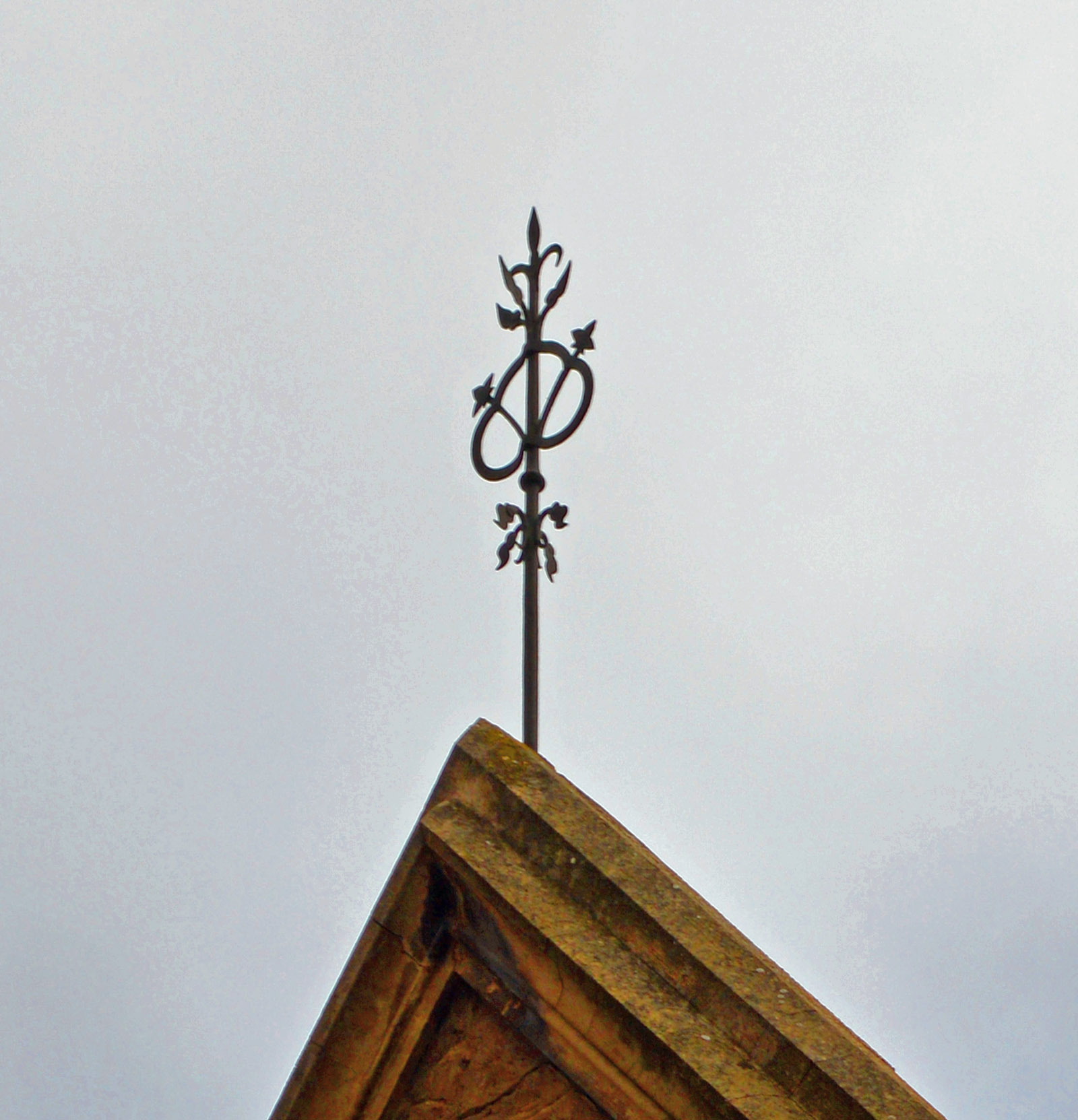
CONCLUSION
Some of the text on this site has come from the Church’s ‘Information Leaflet’ and website. I am happy to acknowledge my use of these publications.
I hope you have enjoyed our tour of Scots Church. After completing a project like this, I am always conscious of things I have missed! So if you have some favourite photograph or extra information you would like to add here, I would be delighted to hear from you.
A collection of my photos used on this site can be found at
https://www.flickr.com/photos/paulscottinfo/albums/
The Church website is
I am grateful to my wife Margie for some final proof-reading, but if there are any further typos, or factual errors, please feel free to contact me. The best websites are those which contain no errors!
Site created 09 / 2013 ; revised 03 /2018 ; reformatted 02 / 2021
Paul Scott

